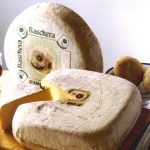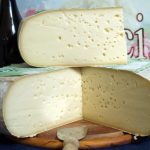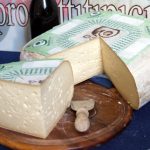
Name
Raschera PDO
Seal of quality
Protected Designation of Origin (PDO) – Reg. EC n° 1263/96.
Description
Raschera PDO is a hard, semi-fat, raw, pressed cheese of an ivory white colour. The fresher forms have a fine and delicate taste, whereas the aged cheese is stronger, persistent and savoury, and is usually sharper. The mountain-pasture Raschera cheese is characterised by the mountain pastures and mountain herbs.
The forms come in two types:
- quadrangular with flat faces, each side from 28 to 40 cm in length, irregular circumference and weight varying from 6 to 9 kg
- round with flat faces, and has a diameter of 30- 40 cm, and a slightly convex 6- 9 cm circumference and weighing from 5 to 8 kg.
Today, 99% of the production comes in square forms (the form that in the past was better suited for mule transport).
Cow’s milk, with rare supplements of small quantities of goat or sheep’s milk, is heated at 29-30° C and whey is added in order to obtain the milk curd. After about one hour, the milk curd is broken down with a paddle and beaten with a thornbush branch for five minutes.
Once separated from the serum, the curd is collected in a hemp cloth and left to drain, after which, processing differs according to whether the cheeses produced are round or quadrangular. In the case of round cheeses, the curd, still wrapped in the cloth, is put into cylindrical wooden moulds of 35- 40 cm in diameter provided with holes along the rim, the so called “fascele”, which are then loaded with weights to allow serum discharge. The cheese remains under these weights for about a whole day and is turned over every hour. Dry salting is carried out, turning the whole cheeses after a day or two to be able to work on both faces.
In the case of square cheeses, the curd is extracted from the round “fascela” and, before salting, is put in a parallelepiped mould, the “conca” made with wooden boards. The cheese in the “conca” is covered with a plank, loaded with weights and stays there for four or five days until it has acquired an irregular square shape
Salting is carried out on all four sides during compression, which involves turning the cheese over every day, while salting on the two flat faces is carried out after removal from the “conca”.
Ageing takes at least 30 days for productions made with hygienised milk and at least 60 days for the raw milk productions.
Nutritional characteristics
Follows the nutritional characteristics of Raschera.
| unit of measurement | Raschera | |
|---|---|---|
| protein | g/100g | 21.1 |
| carbohydrates | g/100g | <1 |
| of which sugar | g/100g | <1 |
| fat | g/100g | 28,5 |
| of which saturated | g/100g | 20,4 |
| of which trans | g/100g | 1,71 |
| cholesterol | Mg/100g | 96 |
| calcium | mg/kg | 6161 |
| iron | mg/kg | 6,03 |
| sodium | mg/kg | 8000 |
| Vitamin A | mg/kg | 2,45 |
| Vitamin C | mg/kg | <1 |
| Energy value | kcal/100g | 341 |
Area of production
Raschera PDO, a typical and historical production of the Monregalese area, can be produced and aged in the administrative region of the province of Cuneo, as established by the disciplinary regulations of production. Raschera PDO can bear the label “di Alpeggio” if produced and aged at an altitude of over 900 metres a.s.l. in the regions of Frabosa Soprana, Frabosa Sottana, and Garessio as regards Valcasotto, and Magliano Alpi, for the part that borders with Ormea, Montalto Mondovì, Ormea, Pamparato, Roburent and Roccaforte Mondovì.

The paper label on Raschera d’alpeggio PDO has a yellow background, whereas the traditional label has a green background so that consumers can easily identify the two types of Raschera.
History
This cheese has always been produced in the mountains of the Monregalese area, and, in witness of its strong relationship with the region, it bears the name of a mountain pasture and a pasture at the foot of Monte Mongioie. Today, the Raschera alp, with an area of over 620 hectares is, in fact, included in the Magliano Alpe region, which actually owes its name “Alpi” to this island of mountains separate from the rest of the local region. To confirm the long tradition of this cheese, the name in dialect “Raschera” is used to indicate cheeses produced in the Monregalese mountains, whereas the name “tuma di montagna” is used to indicate cheeses produced in the mountains, but produced in other valleys.
In 1976, the “Confraternita del Raschera e del Bruss” was founded in Frabosa Soprana, the members of which had the duty of propagating and sustaining production, consumption, knowledge and sale of Raschera cheese. Their enthusiasm and passion for genuine and traditional local products, at a time when production of that dairy jewel named Raschera was in risk of disappearing for ever, triggered a movement of opinion that gradually involved public bodies operating in the area.
Then, in 1982, thanks to the concern and participation of the Chamber of Commerce of Cuneo and the Comunità Montana delle Valli Monregalesi, procedures began for the Guarantee of Origin status (AOC). In 1996, the European Community granted Raschera PDO status.
In 1984, a group of Raschera producers founded the “Consorzio per la tutela del formaggio a denominazione d’origine Raschera“, with the objective of offering consumers guarantee, by means of marks deposited by rule of law, of product authenticity, artisan cheese processing, and the certainty that a cheese marked Raschera is not merely an imitation.








